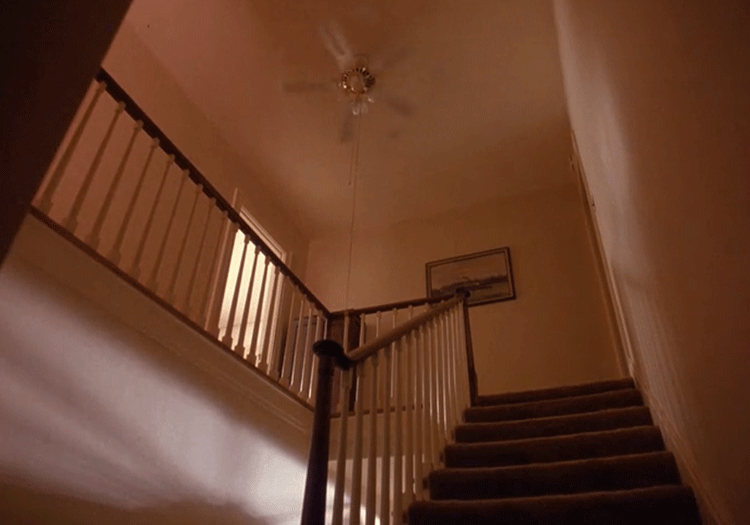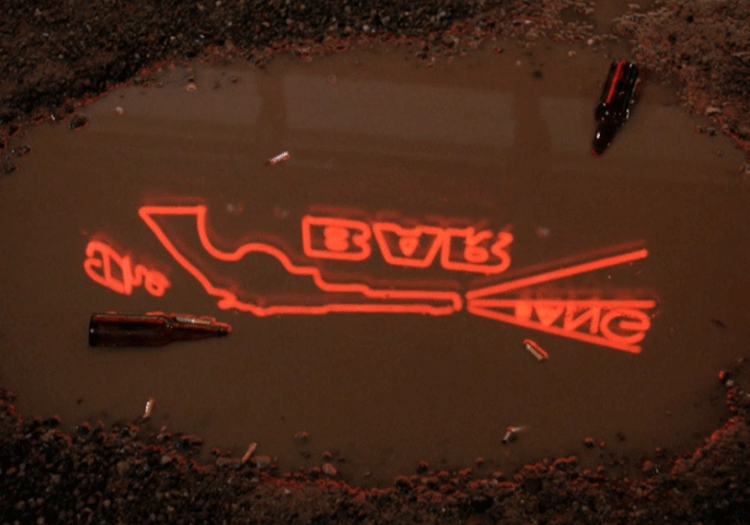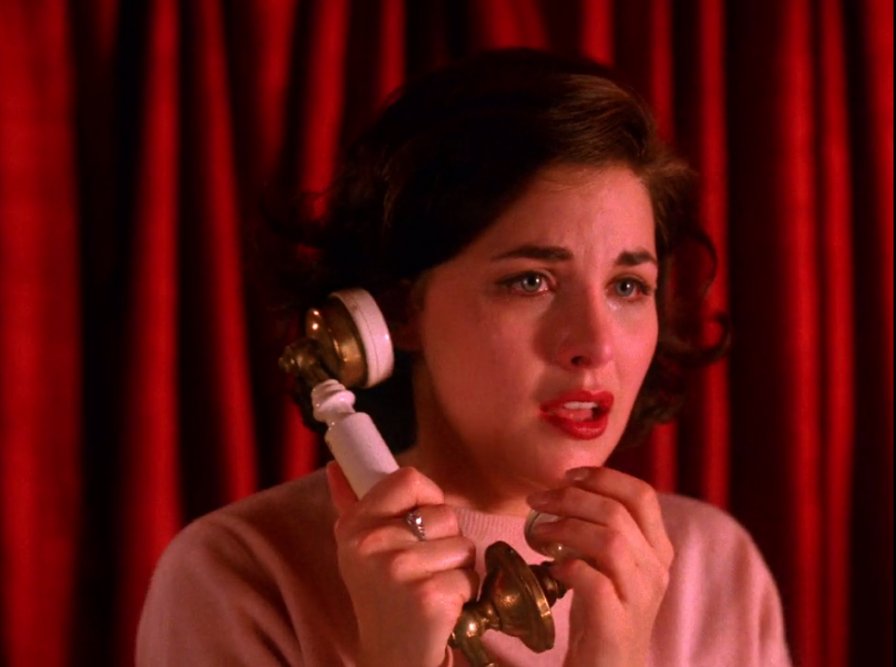David Lynch and Mark Frost's Twin Peaks aired its last episode of season 2 in 1991, over a quarter-century ago. With the series finally making its return for season 3 on Sunday, May 21, we are celebrating all week with a string of Twin Peaks-related features. More from this series
“An accurate memory of the past would be depressing, probably.”
– David Lynch
One of the best jokes in the pilot episode of Twin Peaks occurred when Agent Cooper and Sheriff Harry Truman visit Twin Peaks Savings & Loan and find a mounted deer head laying on its side. The odd response from a minor character (“Oh, it fell down”) underlines a lot of the initial appeal of the series: A seemingly innocuous moment executed with comedic pacing and an absurdity designed to relieve the tension built up from a string of traumatic plot revelations. It’s weird, but not “too weird.” It’s, in today’s language, quirky.
The first two seasons of Twin Peaks are full of these kinds of moments. We have the legendary “damn fine” cups of coffee. We have Major Briggs’s extraordinary wisdom. We have Cooper’s played-for-laughs lesson on the nation of Tibet and the mystic knowledge he draws from it. And, as the second season burrows into its bizarre middle and late periods, we get super-strength, aliens, and Confederate-soldier amnesia. It’s a show whose metaphysics hinge on a dwarf who speaks backward.
These bits have lingered on as a 25-years-running set of passwords. How there was “a fish in the percolator” or how the owls are “not what they seem” or how “it is happening again.” These phrases have been passed along, referenced, parodied, remixed, rebuilt, paid forward into other works that have absorbed the show’s legacy. This tone — humorous, mysterious, offbeat — has been perhaps the most visible product of the show’s brief initial run. Nearly every beloved television series of the intervening generation, from Lost to True Detective to even Glee, has at some point been described as “like Twin Peaks.”
But, within these sometimes scattered ideas about what the series may or may not represent, there begs another question: What do we mean when we say something is “like Twin Peaks”?

Other things that are like Twin Peaks: Wind blowing through a stand of Douglas Fir. A traffic light changing from yellow to red in the darkness. A ceiling fan turning, frighteningly, forever.
When Twin Peaks first aired, I was four years old. I remember sneaking into the living room to see my mom watching the show and, on other nights, hearing Angelo Badalamenti’s music lurking outside my bedroom door. I remember catching a glimpse of Cooper in the Sheriff’s station, his eyebrows up in fear, and hearing synthesizer chords hanging in our hallway, moments that made my mom “afraid.” I remember being up later than I should have been. I remember the lights being off. All mundane, average things somehow made wrong by what was on TV. This, for me, is what I think of as being “like” Twin Peaks.
Because when you talk about Twin Peaks, you are also talking about much more than its plot. There is the TV series, its companion movie, and their various release formats throughout the year. There is the fandom that blossomed around these two pieces of media and their various tie-ins (books, cassettes, merchandising). There is the career of one of its creators and how this single storyworld may or may not speak for the entirety of their body of work. There are GIFs, memes, theme parties, Etsy art, and SXSW pop-up events. There is Log Lady cosplay.
In all this, it’s easy to lose track of the show’s plot: the murder mystery of teenage Laura Palmer, the small-town homecoming queen whose private life was (like those owls) not what it seemed. Alongside its endearing cast and twilight-Borscht Belt sense of humor, it was this mystery that first lured a large network audience to the series’s first season. And, as the reasons for the killing became more elliptical and less grounded to Earth (though maybe more poetically drawing from the show’s interest in the earth and nature), many of those same fans moved on to other fictional universes. In the immediate clearing wrought by Twin Peaks, we got Northern Exposure — also a show “like Twin Peaks” that my mother watched at night, though one that made her less “afraid.” Offbeat, quirky. Weird, but not too weird.

Also like Twin Peaks: A poker chip. The sound of neon crackling through a bar sign. Rope tied around a wrist.
I have a screencap on my desktop of James Hurley — the series’s sensitive bad boy, as opposed to its other criminal bad boys or its demon-possessed bad boys — sitting on a hilltop overlooking the breathtaking view of the mountains bordering the town of Twin Peaks, his motorcycle parked next to him. In the context of the show, James and his motorcycle are sort of a duo (a theme explored with great detail in his much-derided road trip in season 2). In another scene from the pilot, when James drives off from his uncle Ed’s “gas farm,” he slips on a pair of sunglasses before riding away, like it’s no big deal.
For a series whose aesthetic can feel so unique, so precisely defined, much about Twin Peaks feels like an echo of something else. James prefigures Nicolas Cage’s words from David Lynch’s Peaks-contemporary feature film Wild At Heart, where he declares, wonderfully, that his snakeskin jacket is a “symbol of my individuality and my belief in personal freedom.” Hurley, in his leather jacket, on his hog, wearing these shades, wearing his square jaw handsomeness, speaks just as clearly, and ridiculously, and earnestly, to his belief in personal freedom.
Twin Peaks often feels like it is either making fun of something or being deadly sincere about that same thing, oftentimes both at once. Even from the beginning, the dialogue is corny (“Quit worryin’ and start screwin’, Mr. Touchdown”) and many of the jokes don’t “work” in the way one might like them to. This, of course, is also much of what is “like” Twin Peaks: the gap, similar to irony but something much weirder, between what we expect and what we get. It’s disarming. It makes one pause and wonder. It messes deeply with one’s bearing for what, if anything, we’re supposed to be taking seriously here — and why some of these things might be taken more seriously than others. Why do we allow some of this to resonate and not the rest? What does it say about us if we can’t totally “go there”? What will people think of me if I don’t get it?

Another example from Lynch’s pilot that is “like Twin Peaks”: the scene when Laura’s friends first learn of her death in the middle of class. When this discovery comes — illustrated, crushingly, by Laura’s empty desk — her best friend and confidant, Donna, is moved to an explosion of grief. This meme-ready image, of actress Lara Flynn Boyle’s head tilted back in despair, openly weeping, has become an icon of something core to the identity of the Twin Peaks universe: the intrusion of a deep sadness into “normal life.” Maybe more than any violence or supernatural evil, it is this quality — the stuff that brings us to tears — that both disrupts and defines life in Twin Peaks. There are few other television shows or films that allow its characters more frequent and intense displays of things so easily repressed, of actual crying, of more opportunities to react to trauma with not just inner pain but a pandemonium of feelings: terror, rage, screaming.
How does James react in this same scene? James, stone-faced, snaps his pencil in half. It’s quirky, and it’s somehow placed at exactly the wrong moment, the timing completely off.
Also in this scene, which feels equally “like Twin Peaks” despite its seemingly frivolous nature: a poster on the back wall of Abraham Lincoln.

A lot of what we remember about Twin Peaks now is environmental. The red curtains of the Black Lodge and the roadhouse stage, the zig-zag of black and white, tall trees filtered through fog. All of its objects.
Rewatching the series, I tried to make a list of every “object” that felt important. Three episodes in, this list began to feel psychotic: ashtrays, gas pumps, jukeboxes (plural). I wrote the word “lumber” a dozen times. Everything — every “thing” — seemed to carry another meaning. Even the most basic details, after a few hours, vibrated differently. Each lamp felt ominous.
Twin Peaks has hung around for almost three decades partially for this reason. The lasting mystery of the show is less in the question it was marketed under — “Who killed Laura Palmer?” — but in that question of what, exactly, we’re even seeing. Its audience returns to these episodes again and again, because something about them feels unfinished. That creeping feeling that something is not right here, that things have gone terribly, cosmically wrong — and that it still (as James puts it) “makes some kind of terrible sense.”
That the series often asks you to largely throw away logic and to be swept up in its senses, “terrible” or otherwise, is also what has given the show its long life. Lynch and creative partner Mark Frost don’t seem interested in telling the story of Palmer’s murder to “say” anything about her death, or about death in general. They tell this story because it feels a certain way. The haze of American upper-middle-class suburbia — caught temporally between the era of the show’s premiere, the 80s, and that of Lynch’s own childhood, the 50s — is used for a texture of banality, the “normal world” terrorized by the show’s supernatural forces. Like much of Lynch’s work, this resonates the deepest as a kind of dream place, perhaps his attempt to rebuild and remake the specifics of his own youth in order to reveal the sensations he felt buried in there.
And yet: while Twin Peaks may not be the real world, it’s also not only fantasy. And it’s certainly not universal. It is a specific vision with precise references to an era its creators grew up in: neon diner signs, girls in sweater sets, sleazy rock & roll, wall-to-wall carpeting, cassette tapes, the highly stylized signifiers of a mid-century middle-class American culture. These references don’t belong to everybody, but they do belong to the person who dropped a teenager’s murder into the middle of them. They resonate not because they’re ours, but because we can tell they are somebody’s. Many of us might like the chance to revisit and rebuild our childhoods; Lynch just has the privilege of giving us his childhood back to us.
Twin Peaks might not always ask you to think, but it always asks that you feel — deeply, confusingly, uncontrollably. Fitting for a story about spirit possession and a community unprepared to deal with it, when Twin Peaks works, it can seem like a thing that is being done to us, intruding in our own normal spaces, flipping them. Creeping down the hallway. Driving us to host costume parties. Still making us “afraid.” Twin Peaks’s power is that it makes things wrong, but it never makes them right again. The show just continues making them wrong in different ways.
David Lynch and Mark Frost's Twin Peaks aired its last episode of season 2 in 1991, over a quarter-century ago. With the series finally making its return for season 3 on Sunday, May 21, we are celebrating all week with a string of Twin Peaks-related features. More from this series
